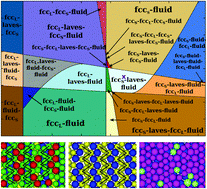当前位置:
X-MOL 学术
›
Soft Matter
›
论文详情
Our official English website, www.x-mol.net, welcomes your feedback! (Note: you will need to create a separate account there.)
Towards the colloidal Laves phase from binary hard-sphere mixtures via sedimentation
Soft Matter ( IF 3.4 ) Pub Date : 2018-03-21 00:00:00 , DOI: 10.1039/c8sm00237a Tonnishtha Dasgupta 1, 2, 3, 4, 5 , Marjolein Dijkstra 1, 2, 3, 4, 5
Soft Matter ( IF 3.4 ) Pub Date : 2018-03-21 00:00:00 , DOI: 10.1039/c8sm00237a Tonnishtha Dasgupta 1, 2, 3, 4, 5 , Marjolein Dijkstra 1, 2, 3, 4, 5
Affiliation

|
Colloidal photonic crystals, which show a complete band gap in the visible region, have numerous applications in fibre optics, energy storage and conversion, and optical wave guides. Intriguingly, two of the best examples of photonic crystals, the diamond and pyrochlore structure, can be self-assembled into the colloidal MgCu2 Laves phase crystal from a simple binary hard-sphere mixture. For these colloidal length scales thermal and gravitational energies are often comparable and therefore it is worthwhile to study the sedimentation phase behavior of these systems. For a multicomponent system this is possible through a theoretical construct known as a stacking diagram, which constitutes a set of all possible stacking sequences of phases in a sedimentation column, and uses as input the bulk phase diagram of the system in the chemical potential plane. We determine the stable phases for binary hard-sphere systems with varying diameter ratios using Monte Carlo simulations and analytical equations of state available in literature and calculate the corresponding stacking diagrams. We also discuss observations from event-driven Brownian dynamics simulations in relation to our theoretical stacking diagrams.
中文翻译:

通过沉降 从二元硬球混合物向胶态Laves相转变
胶体光子晶体在可见光区域显示出完整的带隙,在光纤,能量存储和转换以及光波导中具有许多应用。有趣的是,光子晶体的两个最佳实例,即钻石和烧绿石结构,可以自组装成胶体MgCu 2。Laves相晶体来自简单的二元硬球混合物。对于这些胶体长度尺度,热能和重力能通常是可比的,因此值得研究这些系统的沉积相行为。对于多组分系统,这可以通过称为堆积图的理论构造来实现,该构造图构成沉淀塔中所有可能的相堆积顺序的集合,并将系统在化学势平面中的整体相图用作输入。我们使用蒙特卡罗模拟和文献中提供的状态分析方程式确定具有不同直径比的二元硬球系统的稳定相,并计算相应的堆积图。
更新日期:2018-03-21
中文翻译:

通过沉降 从二元硬球混合物向胶态Laves相转变
胶体光子晶体在可见光区域显示出完整的带隙,在光纤,能量存储和转换以及光波导中具有许多应用。有趣的是,光子晶体的两个最佳实例,即钻石和烧绿石结构,可以自组装成胶体MgCu 2。Laves相晶体来自简单的二元硬球混合物。对于这些胶体长度尺度,热能和重力能通常是可比的,因此值得研究这些系统的沉积相行为。对于多组分系统,这可以通过称为堆积图的理论构造来实现,该构造图构成沉淀塔中所有可能的相堆积顺序的集合,并将系统在化学势平面中的整体相图用作输入。我们使用蒙特卡罗模拟和文献中提供的状态分析方程式确定具有不同直径比的二元硬球系统的稳定相,并计算相应的堆积图。



























 京公网安备 11010802027423号
京公网安备 11010802027423号